RESULTS
1 – Differential induction of innate immunity response by bacteria in SEBO662AR cells. Chemokine and cytokine (IL-6) transcripts expression.
2 – Differential induction of innate immunity response by bacteria in SEBO662AR cells. Antimicrobial peptides transcripts expression.
CONCLUSIONS
In this model,
– Bacteria differentially induce the overexpression of CXC chemokines, CCL20 and the pro-inflammatory cytokine IL-6. It is also the case for antibacterial peptide transcripts S100A7 and β-defensin 2 (BD2), but with an apparent different selectivity.
– DHT treatment decreases the expression of the chemokines and IL-6 both at the mRNA and protein level and can be regarded as an “innate immunosuppressor”.
– We expect a different mechanism for antibacterial peptides overexpression, on which we observed no significant effect of DHT.
– Finally, bacteria (C. acnes) potentialized the DHT-induced accumulation of lipid droplets in SEBO662AR cells.
– These experimental data could be regarded as preliminary elements suggesting a possible cooperation between infection and androgens in sebaceous disorders.
REFERENCES
1 Barrault et al. (2015) J Steroid Biochem Mol Biol ;152:34-44
2 Garcia et al. (2018) Virulence; 9: 1163-1175


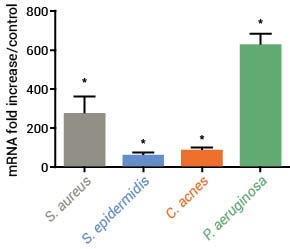
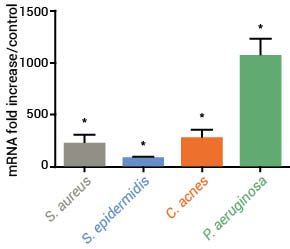
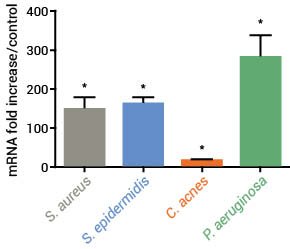
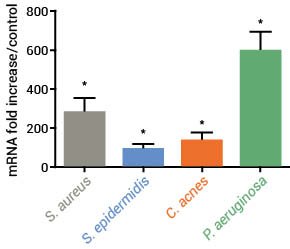
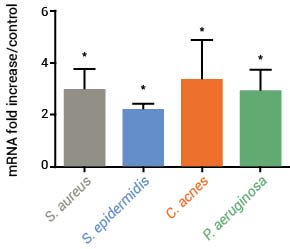
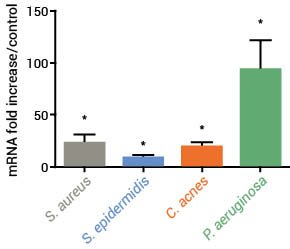





Innate immunity activation of sebocyte cells by living bacteria. Evidence of a potential immunosuppressive effect of DHT.
Acné, Acné, Microbiome cutané, Microbiome cutané, Microbiome cutané, Sebaceous gland regulationAcne is a skin pathology targeting the pilosebaceous unit…sebum hypersecretion and bacterial infection. We studied the effects of living bacteria on the induction of an innate immune response in a sebocyte cell line.
Pharmacological effects of anti-androgens and other compounds in an androgen-sensitive sebocyte cell line.
Acné, Acné, Sebaceous gland regulationWe analysed the activity of reference anti-androgens (Finasteride, Dutasteride, Cyproterone acetate), at the level of their potential targets (5-alpha-reductase, AR translocation, induced transcripts) and in a functional lipid accumulation assay. We also evaluated this androgen-induced lipid accumulation assay as a potential pharmacological tool to detect potential inhibitors from both androgenic and non-androgenic origins.
Androgens activate lipogenesis through an AKT-independent mTOR pathway stimulation and a limitation of autophagy in an androgen-sensitive sebocyte cell line.
Acné, Acné, Peau grasse, hyperséborrhée et séborégulation, Sebaceous gland regulationAndrogens are key regulators of sebaceous function… A link between mTOR and androgen signaling has previously been reported…as well as a link between these processes and lipid synthesis…Here we aimed at confirming that DHT-induced lipid synthesis/accumulation is at least in part dependent on mTOR activation in the SEBO662AR cell line and that the autophagic process is consequently modified by the androgenic treatment.
Acné vulgaris : Origines, symptômes et traitements actuels
AcnéL’acné vulgaris est une maladie inflammatoire chronique cutanée qui touche la plupart des adolescents et concerne plus de la moitié des consultations en dermatologie. Cette pathologie, caractérisée par une hypersécrétion de sébum peut être à l’origine de complications d’ordre physique pouvant également entraîner un certain mal-être psychologique.
Acné vulgaris : Physiopathologie et mécanismes cellulaires
Acné, Peau grasse, hyperséborrhée et séborégulationL’acné vulgaris est une pathologie inflammatoire chronique cutanée localisée au niveau du follicule pilo-sébacé. Elle apparaît suite à une surproduction de sébum liée à des dysfonctionnements d’origine hormonale (androgène), environnementale (pollution…) et à la colonisation du follicule pilo-sébacé par certaines bactéries (P. acnes).
(Dans ce contexte), QIMA Life Sciences a développé un panel de tests originaux destinés à la découverte et l’évaluation de composés pour le traitement de l’acné.
La glande sébacée : Physiologie et fonctions
Acné, Barrière cutanée et hydratation, Peau grasse, hyperséborrhée et séborégulationLa glande sébacée est un organe localisé au niveau du derme. Elle est responsable de la synthèse et de la sécrétion du sébum qui entre dans la composition du film hydrolipidique. Le rôle du sébum est de protéger la peau des agressions extérieures et de la déshydratation. Le sébum permet également d’entretenir la souplesse de la peau et des cheveux.